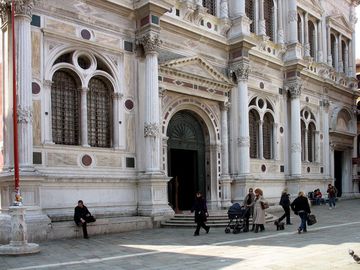

The St Roch Confraternity was founded in 15th century by a group influential Venetians venerating the protector from the plague. The building that we see today was built in the beginning of 16th century by a series of alternating architects: Bartolomeo Bon, Sante Lombardo, Antonio Scarpagnino and Giangiacomo dei Grigi. Just like all Venetian confraternities, the Scuola Grande di San Rocco has two main halls: one on the ground floor, the Sala Terra, and one on the upper floor, the Sala Superiore. The upper hall, which was used for daily assemblies, leads to the Sala dell'Albergo, the room in which, in modern terminology, the board of directors would meet.
The St Roch Confraternity building in itself is a standard Venetian Renaissance structure, but the series of paintings that it houses is one of the greatest contributions to biblical painting in the history of art. The series contains roughly forty paintings executed by Jacopo Tintoretto, together with his assistants and son Domenico, in the end of 16th century, and dedicated to the Old and New Testaments. But more than just an illustration of the Bible, Tintoretto - with the help of the confraternity's theologians - tried to emphasize the episodes in the Old Testament that prefigured the story of Christ. The confraternity wished to demonstrate how the coming of Christ was already anticipated in the Jewish Sacred Scripture, a view that, as history witnessed, was not accepted by the Jewish faith.
On the ceiling of the Sala Superiore we see the Old Testament episodes, those dealing with Adam and Eve, with Moses, the prophets Elijah, Elisha and Ezekiel, etc. The order of the paintings was carefully planned according to the Bible's chapters. The painting of Adam and Eve, in fact, is turned in the other direction, signifying that the two had still existed in a state of perfection and oneness with God. Then came the fall.
The walls of the Sala Superiore are covered by scenes from the New Testament. An example of this biblical prefiguration is Moses holding up the stick with the bronze serpent to save the Hebrew people from venomous snakes, an event that Christian theologians think presaged the crucifixion of Christ the Redeemer. The Sala dell'Albergo presents us with more dramatic paintings of Christ's final days on Earth, including Christ before Pilate, Ecce Homo, Ascent to Calvary and The Crucifixion. The paintings in the Sala Terra are dedicated to the Virgin Mary, as well as to St. Mary Magdalene and St Mary of Egypt.
The confraternity contains another very particular painting, which is also found in the Sala Superiore: Christ carrying the cross. To this day scholars have not been able to determine whether the work was executed by Giorgione or by Titian, two artists who worked closely together in the beginning of the 16th century. In fact, they were the two rising stars of Venetian painting, friends but also rivals, and if Giorgione had not died at a young age, it is possible that Titian would not have been the only comet consuming the Venetian sky.
16th century Venice produced a wide range of important painters, but the three essential masters are considered to be Paolo Veronese, Jacopo Tintoretto and Titian Vecellio. Giovanni Bellini, who died in 1516, also had that status, however his style and technique belong to 15th century painting. Out of the three aforementioned painters, the one who demonstrated the most diversity and innovativeness, and who achieved fame throughout the entire European continent during his lifetime, was obviously Titian.
Tintoretto, however, due to his extremely pious nature, was always held in high esteem by Venice's Catholic authorities. He was born Jacopo Robusti in 1519 and assumed the surname Tintoretto because his father worked in the field of coloring or dying, which in Italian is 'tintura', hence 'Tintoretto,' one who colors. Jacopo became an assistant to Titian, but for some reason was dismissed several days later, either because there was a clash of temperaments or because Titian feared that he would be nurturing the talent of his own rival. Tintoretto became popular after his work for the Scuola Grande di San Marco in 1542, and from then on concentrated mostly on religious painting. He was heavily influenced by the Counterreformation movement sweeping throughout Italy in the middle of the 16th century. The Vatican's rigid emphasis on spirituality, as a consequence of Martin Luther's attack on the materialism of the Catholic Church during the Reformation, inspired artists to develop new ways of expressing the dynamics of the human soul. It is at this time that Tintoretto's painting became more and more phantasmagorical, depicting his human subjects as spiritual phenomena without a precise awareness of space and time. Tintoretto also painted many works for the government, celebrating the glory - spiritual and political - of the Venetian Republic. His most famous piece in this genre is the enormous Paradise, the largest canvas painting in the world, which covers the entire eastern wall in the Great Council Chamber of the Doge's Palace.
Tintoretto hardly travelled outside of Venice. He lived in a four-story house in the Cannaregio Sestiere with his five daughters and two sons. His son Domenico also became an established painter, though never as great as his father. Tintoretto died in 1594 and was buried next to his daughter Marietta in the Church of the Madonna dell'Orto, for which he had created many paintings throughout his career.
Without doubt the St Roch cycle is Tintoretto's tour de force. It is definitely his most original series of paintings and perhaps his most evocative. In it he reached the pinnacle of his artistic career, leaving us a monumental illustration of some of the most complex and fascinating concepts of the Old and New Testaments.